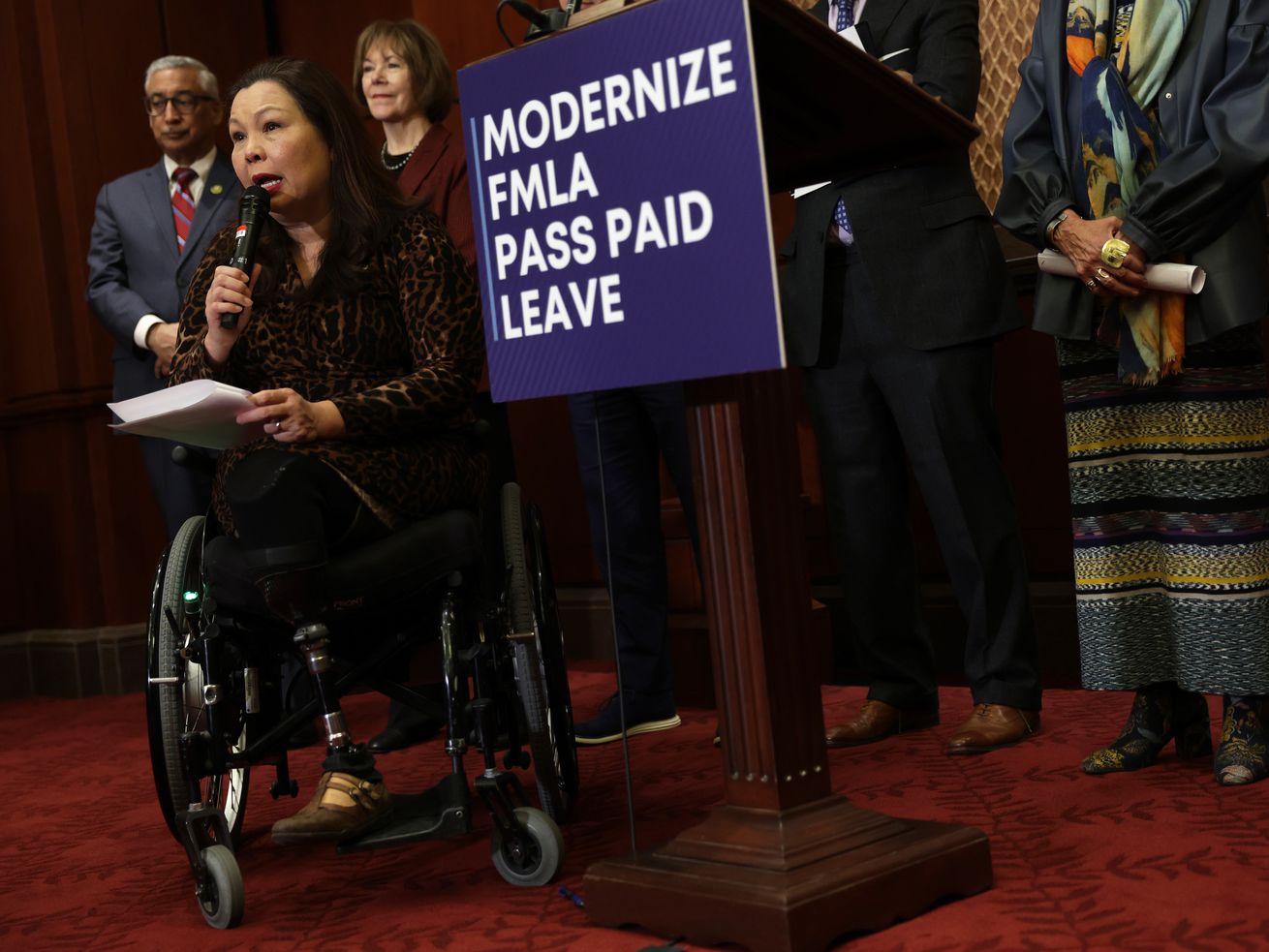
It’s the 30th anniversary of the Family and Medical Leave Act. There are still huge gaps in federal policy.
This week marks the 30th anniversary of the Family and Medical Leave Act, which guarantees most workers 12 weeks of unpaid leave to care for a child, a sick family member, or themselves, if they fall ill.
The Family and Medical Leave Act, also known as FMLA, was passed in 1993 and was a revolutionary policy: Until then, workers had no guaranteed protections if they needed time off after having a baby or to recover from an illness. That legislation, however, still left out millions of workers, including part-time employees and those who work at small businesses — a 2018 Labor Department survey found that 44 percent of workers aren’t covered by it. Many of the bill’s gaps still exist, and there remains no paid leave program at the federal level.
There has been some progress, however. In the years since the passage of the FMLA, 11 states and Washington, DC, have approved their own paid leave policies, and some states have also offered more extensive unpaid leave options. A higher proportion of workers than in 1993 also now have paid leave via their employers, and research from Health Affairs and the Institute for Women’s Policy Research has found that such programs have improved kids’ health outcomes and boosted women’s retention in the workforce.
Today, lawmakers are still pushing to advance a comprehensive federal bill on the issue, though the current state of divided government means it will be difficult to do so. Last year, Congress failed to approve paid family and sick leave due to opposition from both Democratic Sen. Joe Manchin (D-WV) and Republicans.
Functionally, the lack of a federal policy has meant a wide array of policies that differ by state and employer. “Heck, even in the Senate, every Senate office is different,” says Sen. Tammy Duckworth (D-IL), who recently put forth legislation to ensure that educational support professionals, like bus drivers and janitorial staff, who are left out of FMLA, get covered.
Duckworth sat down with Vox to talk about that bill — and the state of paid and unpaid leave in the US, 30 years after the landmark passage of the FMLA. This interview has been edited for length and clarity.
Li Zhou
Let’s start with the state of unpaid leave in the US today: Who has access to it, and who’s left out?
Sen. Tammy Duckworth
Right now, in order to qualify for FMLA, over the course of 12 months, you need to have worked 1,250 hours. So you think of full-time work in a year, 2,000 hours is a good rule of thumb to go by. You need to work 1,250 hours at your job, at this one job, in order to qualify for FMLA under that employer. I’ve introduced the Education Support [Professionals] Act, the ESP Act, because those folks who work in the American educational system, because it’s a nine-month system, a lot of workers never get to the 1,250 hours with the school district.
They end up having to have two jobs: one job for nine months, and then another job for three months. And at neither job do they get to 1,250, so they don’t qualify for FMLA. And who are these people, these are your school bus drivers, your lunch ladies, this is your school nurse.
Think about during the pandemic, when our school nurses were on the front lines checking and testing all of our kids for Covid to allow kids to go back to classroom work. And yet they themselves did not qualify to get unpaid FMLA if they were to get sick.
My bill would change the way we calculate FMLA to a percentage of the total number of hours that they would be expected to work for that time period of that job, so that they would only be evaluated based on, in nine months, the total number of hours worked. If they work full time at their job, let’s say it’s 1,500 hours, then to qualify, it’s 1,000, whatever that is. We would have a better formula to figure out people’s qualifying for FMLA. And particularly, to make sure that educational support staff get to that qualification threshold.
Li Zhou
In general, who do you see getting left out of FMLA based on the factors currently used to determine who qualifies?
Sen. Duckworth
It’s people who work multiple jobs. Many families, especially single mothers, they cobble together two or three jobs in order to make enough money to support their families. And because of that, because they’re not at a single employer for that entire year, they don’t end up qualifying, even though they are working sometimes a lot more than 2,000 hours a year. And it makes it really hard for them to qualify for FMLA.
[Editor’s note: Workers at businesses with fewer than 50 employees also aren’t guaranteed coverage under FMLA, and legislation has been introduced to address this issue, including the Job Protection Act from Rep. Lauren Underwood and Sen. Tina Smith.]
Li Zhou
When we think about paid leave, who is covered by that and how is that determined?
Sen. Duckworth
It’s dependent on your employer, if your employer provides paid leave or not. And even in different parts of government, you have different coverage. Heck, even in the Senate, every Senate office is different. So some Senate offices provide more coverage than others and have different rules than others. And so there’s no consistency across the country and who qualifies for what in terms of paid leave because it’s treated as a benefit of your employment.
The FAMILY Act introduced by Sen. [Kirsten] Gillibrand, which I’ve been a co-sponsor of now for a number of years, would solve this problem by actually creating an insurance program that would cost about $2 a week for the employer and $2 a week for the employee. And what would happen is, you would both pay into that. And if you needed to take paid leave, you could get paid up to 80 percent of your salary depending on what you choose to pay for under the insurance program.
So kind of like how you have your health care, you can choose a silver or gold or a platinum plan, it will be kind of the same thing where you could choose how much benefit you would want to be able to get, what percentage of your salary you’d like to be able to draw if you needed to go on leave, and then you would pay into the program for that. And that would be a way to get paid family leave into effect across the country for everyone, and not at taxpayers’ expense, because it would be between the worker and the employer.
Li Zhou
What do you see as the biggest obstacles to Congress passing both an expansion to FMLA and something like the Family Act that would provide federal paid leave?
Sen. Duckworth
I think some of the opposition, traditionally, has been from business, who think it’s going to cost too much money. But I will tell you that in the states that have adopted paid leave, like California, when employers have been surveyed, [an overwhelming proportion] have said, actually having paid leave has been a benefit to my company, and did not cost me more money. And in fact, was a great tool for me to retain my employees. And I got more out of it than I had to pay into it.
So in those states that have since adopted paid family leave, we’re seeing that it actually is very well-received. So you’re starting to see the opposition to it sort of fall among businesses that traditionally would have said, “Oh, no, we don’t want to do that.” But now that many of them have experienced it in some of these states, they realize actually, this is saving me money, because I’m not having to retrain workers, I’m not losing workers. Right now there’s a worker shortage, so it actually helps people to retain people to provide paid family leave.
Li Zhou
At this point, what’s your strategy for getting legislation on this issue through in a divided Congress?
Sen. Duckworth
It’s really just going to talk to folks, and I think I’m gonna have a much easier time explaining this to them now than prior to the pandemic. And I use that school nurse as an example. People understand how important these support workers are to our children, and how vital they have been to keeping our children safe.
And they also see that there’s been a real shortage because a lot of the support staff have dropped out of the workforce in the educational system. I know that there’s a school bus driver shortage everywhere, because a lot of them had to quit, because they couldn’t get FMLA during the pandemic. And so they quit and went and got other jobs, because they couldn’t take care of their families that they needed to. So I think the result of not having educational support workers covered has become very evident. And so I think I can make a better case on my end for my Republican colleagues.

Recent Comments